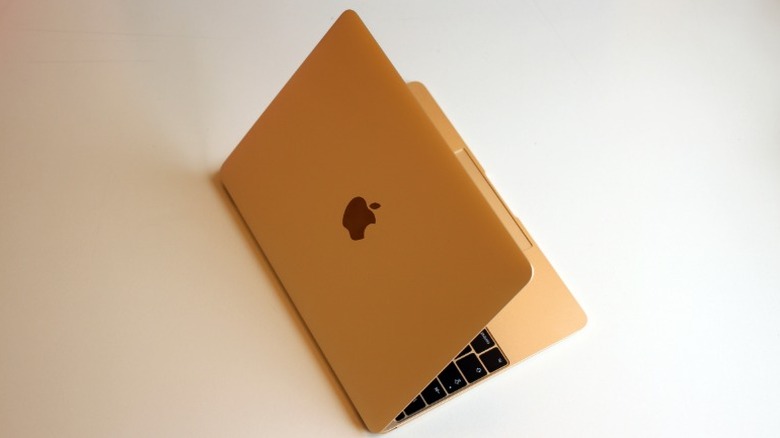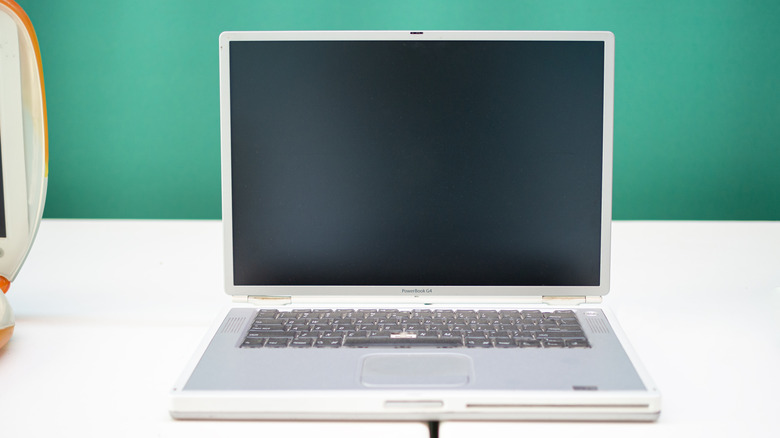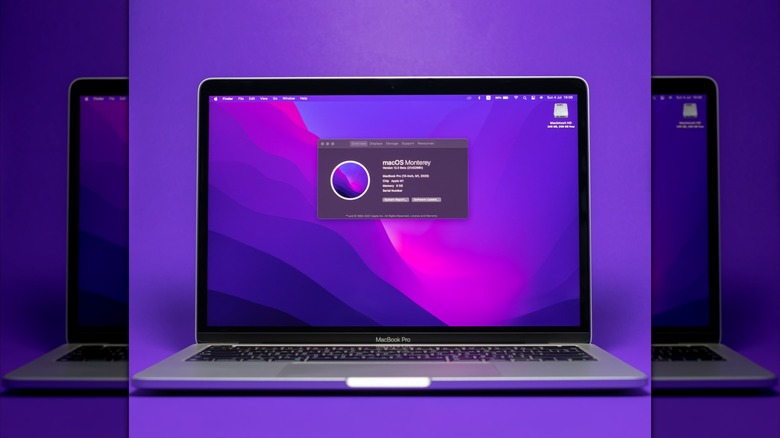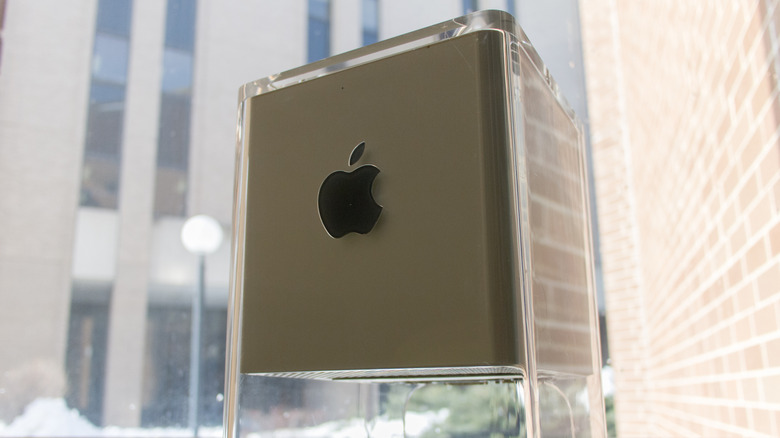The 8 Best Looking Apple Computers Ever Designed
In the late 1970s, two Steves founded Apple Computer, Inc, with operations starting out in Steve Jobs' garage. With him was Steve Wozniak, and the two would go on to revolutionize not just the computer industry, but the entire technology sector on a global scale.
While the company had its ups and downs, the foundations laid by Wozniak and Jobs in the '70s — and all of the smart decisions both of them made along the way — have led to Apple becoming a trillion dollar company today. These days, Apple covers multiple facets of tech, including smartphones, audio, VR headsets, and of course, computers.
The Macintosh, nowadays known as the Mac, has been Apple's line of computers that served as direct competition to Windows-powered computers. Macs have always distinguished themselves as being computers for the higher end, and their designs almost always reflected that. Here are the best looking computers that Apple ever designed.
Twentieth Anniversary Macintosh
Most commonly known under the acronym TAM, this flagship Mac was released in 1997 to celebrate Apple's 20th anniversary. The audio hardware, custom designed by Bose, was contained in a giant cylinder, a design that would appear once more on the 2013 refresh of the Mac Pro. The metal cylinder is the weak link in this case, as the TAM's design really shines through on the monitor.
Actually, the monitor piece contains more than just the monitor. It also includes a 4x CD-ROM drive and a floppy drive, which take up quite literally half of the monitor panel. The monitor itself was a very contemporary matrix LCD with a 12" screen. It included a separate power supply and built-in subwoofer, as well as a trackpad from the PowerBook devices.
Under the hood was the PowerPC 603e processor running at 250 Mhz, paired up with an ATI Rage 3D graphics chipset. It's funny by modern standards, but back in 1997, this machine was state of the art. It also started at $7,500 in 1997, almost $15,000 in today's money.
[Featured image by Kai Wegner via Wikimedia Commons | Cropped and scaled | CC BY 2.0]
iBook G3
By the late 1990s, it was clear that Apple had gotten bored of appeasing the enterprise and professional market. In 2001, Steve Jobs came out on stage at that year's WWDC to announce the latest evolution of the consumer focused iBook, the G3.
This was one of Apple's first consumer grade laptops to truly take off, and it laid the foundations for the later consumer focused MacBooks like the 2015 12" MacBook and the current MacBook Air. One of the most notable aspects of the iBook G3 was its design. It resembled the iMac G3, in itself one of the strangest Macs of all time.
The very period-correct rounded shape and its flashes of color here and there really worked, and even to this day, the iBook G3 is one of the most recognizable laptops in history. Powering the iBook G3 was standard Mac fare for the time, a PowerPC 750 CPU running at 300 Mhz, various hard drive options, and a pretty high-res — for the time — 1024x768 screen. The G3 revision also included an AirPort, which we know today as wireless internet or Wi-Fi Despite being discontinued in 2003, from a design standpoint the G3 can still hold its own even with Mac OS X.
[Featured image by D' via Wikimedia Commons | Cropped and scaled | CC BY-SA 2.0]
Power Mac G5
Before the Mac Pro, Apple's flagship desktop towers had an even more authoritative name: Power Macintosh. First launched in 1994, the Power Macs were the first computers to use PowerPC architectures, which Apple stuck with until 2006 and the switch to Intel architectures. The best-looking iteration of the Power Mac is undoubtedly the G5.
Launched in the early 2000s, the G5 had the most serious design language out of all of them, but also what had to be the coolest design language. A solid metal tower with a mesh design on the front, and grab handles that integrated into the lines of the case.
Such a menacing looking tower also deserves good power, and that was certainly the case. The Power Mac G5 used various PowerPC CPUs throughout its life, all of which used a 64-bit architecture. 64-bit is the norm today, but it was really uncommon back in the early 2000s. The last and most powerful G5s were clocked up to 2.5 GHz, an absurdly high number by the standards of the day. GeForce graphics did all the graphics heavy lifting, and you could spec the G5 with up to 16GB of RAM. Proper workstation stuff.
[Featured image by Bernie Kohl via Wikimedia Commons | Cropped and scaled | CC 1.0]
MacBook 12 (2015)
2015 saw the launch of what can best be described as a highly experimental MacBook. Instead of a Core i5 or Core i7 processor, the original 12" MacBook used an Intel Core M CPU and joined the Air as an entry level consumer grade Apple laptop.
The 12" MacBook, like the name implies, also had a much smaller footprint than any of its stablemates, which left no room for active cooling. However, with such a low power chipset it wasn't necessary.
We really enjoyed the the 12" MacBook when it launched and praised it for distilling everything that made the MacBook so good into such a tiny, more consumer-focused package. The biggest criticism levied at the earliest tiny MacBook was its single USB-C port, which you were forced to use for everything. Apple kept the 12" MacBook around for a few more years, but it went away in 2017.
[Featured image by Maurizio Pesce via Wikimedia Commons | Cropped and scaled | CC BY 2.0]
PowerBook G4 / 2006 MacBook Pro
As well as the Power Mac line of desktop towers, Apple also had a Power laptop line called the PowerBook. Whereas the iBook line used mostly plastic in its construction, the later PowerBook line of laptops was 100% metal, and some of them even came in titanium like the most recent iPhone models.
Back in the early 2000s, experimentation was the name of the game when it came to portable computer design. Acer was making bright red Ferrari laptops, Asus threw its hat in the ring with the Lamborghini laptop, and various companies were cramming full Windows — including keyboards and mouse inputs — into devices the size of present-day smartphones.
In comparison to those, the PowerBook G4, the last Apple laptop to use a PowerPC CPU, looks almost impossibly sleek and understated. It's a masterclass of design that lives up to the Power part of its name, and it's no surprise that every Apple laptop that came after it follows a similar design philosophy. Of course, the most notable thing about the PowerBook G4 was its 2006 rebranding to a name that we're all familiar with — the MacBook Pro.
MacBook Air (M2)
2022 saw the first proper redesign of the MacBook Air in years. The screen bezels were slimmed down significantly and Apple also added the display notch that was previously only seen on the Pro line. A boxier overall design that was now even all the way around was introduced, along with, finally, the return of the much loved MagSafe charging.
The 2022 Air was also moved to the M2 system on a chip, the second generation of the in-house designed Apple Silicon chipsets. Even though this is an ARM-based processor, it makes mincemeat of most tasks. I am using a 2022 M2 MacBook Air to write this, and when I first got it, it was so snappy, I had to check if the display is 120Hz or more. It isn't, but it certainly felt that way coming off an ancient (by comparison) Windows desktop with a puny Skylake Core i3.
This evolution of the Air's design is a truly fantastic one, and it really is one of the sleekest laptops on the market right now. Not biased, I promise, it just is. The Midnight color that was introduced in the 2022 Air certainly contributes to that — when it's not caked in fingerprints and dust, that is.
MacBook Pro (Apple Silicon)
For those take on more demanding tasks on a daily basis, the Apple Silicon-powered MacBook Air is probably best avoided. A more appropriate choice would be the MacBook Pro, which is designed to chew through really tough tasks like it's nobody's business. Ever since the Pro line moved to the in-house Apple Silicon chipsets in 2020, it has become one of the very best laptops on the market — assuming money is no object, of course.
The most recent iteration is the M4-powered MacBook Pro, and once you dry your eyes from the eyewatering price tag, it's almost unbelievable that a laptop has this kind of horsepower. Naturally, because Apple pays attention to the details, it's also quite the looker.
From the big Retina display on the front, to the keyboard and its black backing regardless of the body color, to the precisely crafted exhaust ports on either side of the keyboard, the MacBook Pro does things that were only really possible on massive workstations a few years ago, but it also does it in style.
PowerMac G4 Cube
While the PowerMac lineup was always fantastic, one of the potential issues that could crop up for a lot of users was their sizing. The PowerMac towers were quite the bulky machines, and if there's a space constraint on the user's desk, it could prove to be a problem. Apple's solution was the very sleek PowerMac G4 Cube.
Launched in July of 2000, the G4 Cube had all of the horsepower and the performance of the standard PowerMac G4, but it introduced a much more compact design in the shape of — you guessed it, a cube.
Powering the Cube was a PowerPC G4 processor that could be configured up to 500 Mhz and up to 1.5GB of RAM was also on offer. The G4 Cube was also a total revolution in one important aspect — it was one of the very first computers to be passively cooled. This is where the foundations of the modern Mac mini were laid, and the Cube is definitely a key part of Apple's computer history.
[Featured image by Patrick Kuhl via Wikimedia Commons | Cropped and scaled | CC BY 2.0]








